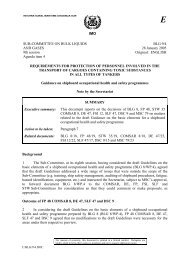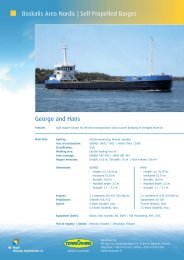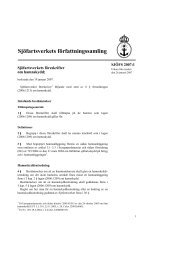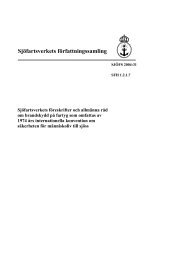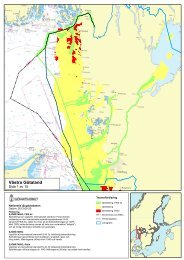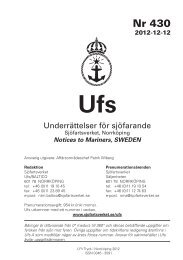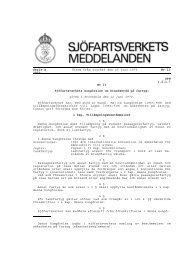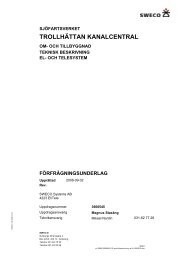AIS - Automatic Identification System
AIS - Automatic Identification System
AIS - Automatic Identification System
Create successful ePaper yourself
Turn your PDF publications into a flip-book with our unique Google optimized e-Paper software.
International Association of Marine Aids<br />
to Navigation and Lighthouse<br />
Authorities (IALA)<br />
presented the first<br />
proposal of <strong>AIS</strong> to<br />
IMO. IALA is mainly<br />
dealing with shore<br />
based aids to navigation<br />
including Vessel<br />
Traffic Services (VTS).<br />
The problem to identify<br />
ships on the radar<br />
displays in the VTS<br />
centres was, however,<br />
one of the reasons for<br />
the VTS committee of<br />
IALA to initiate the<br />
development of a Digital Selective<br />
Calling (DSC) transponder system (<strong>AIS</strong>). Their<br />
operational requirement for the <strong>AIS</strong> was mainly focusing on the<br />
needs of the VTS stations to identify radar targets approaching<br />
the coast. Requirements from seagoing mariners and others<br />
with interest in <strong>AIS</strong> were not looked at.<br />
Who is demanding <strong>AIS</strong><br />
and who could derive advantage from <strong>AIS</strong><br />
The demand from politicians and maritime authorities to<br />
monitor movements of ships in their territorial waters, in order<br />
to prevent accidents and maritime disasters is rapidly increasing,<br />
Coastal states are responsible for traffic separation schemes,<br />
routing areas and fishing areas in their territorial waters.<br />
These states demand compulsory compliance by the users of<br />
these waters and have a need to control “areas to be avoided”.<br />
The fact that users are monitored and identified from shore<br />
will most probably result in a greater compliance with traffic<br />
separation schemes, routing measures and fishing regulations.<br />
It has been argued that accidents in coastal areas could be<br />
avoided, if ships were identified. This is maybe true in some<br />
cases, but a shore based station, identifying a ship, is limited to<br />
advise actions only by using the VHF radio communication<br />
facilities. Furthermore, misunderstandings of the advice can<br />
appear due to, for instance, language problems.<br />
The Exxon Valdez, the Aegean Sea and the Braer were all<br />
identified, long before they ran aground. Consequently, radio<br />
contact is not always the solution.<br />
The only person to stop the engine or change the course to<br />
avoid a grounding or collision is the Officer Of the Watch<br />
(OOW). The OOW is also deciding on actions to follow in<br />
order to comply with the Collision Regulations (COLREG).<br />
Ships equipped with <strong>AIS</strong> enables the OOW´s to be the first<br />
ones to benefit from the <strong>AIS</strong> system by getting an improved situation<br />
awareness capability.<br />
Ambiguous calls, with a stressed voice, in the night, as:“Ship<br />
on my starboard side, ship on my starboard side, this is M/S XXX,<br />
I am turning to port”, have made many OOW´s wishing for an<br />
<strong>AIS</strong> to identify M/S XXX and to get the information about<br />
when and how much M/S XXX is turning and to whom she is<br />
directing her call. All the OOW´s, within radio range, will be<br />
put under severe stress due to this inaccurate and incomplete<br />
information. The stress will last until at least the ARPA radar<br />
equipped ships, after two to three minutes, will detect that one<br />
of the targets on the display is turning and might be M/S XXX.<br />
It has been argued that OOW´s, onboard <strong>AIS</strong> equipped ships,<br />
sometimes will actively agree on actions in conflict with<br />
COLREG, due to their knowledge about the name of the other<br />
ship.<br />
This might happen, but one must not forget that mariners<br />
make such calls anyway today without knowing whom they are<br />
addressing. To prohibit the OOW to use <strong>AIS</strong> would be like to<br />
prohibit the use of radar.<br />
Pilots, barge captains, ferries etc.<br />
In very busy areas, as harbours, rivers and archipelagos, the<br />
need for a high update rate mode <strong>AIS</strong> is evident. The<br />
limitations of the ARPA radar to track ships due to target<br />
swapping from a ship to land, beacons, bridges and other ships<br />
makes the ARPA capabilities very limited in narrow and<br />
congested waters.<br />
Today there is a strong feeling among mariners navigating in<br />
harbours, rivers and archipelagos, that <strong>AIS</strong> will improve the<br />
safety and to a great extend solve the “limitations of the radar”<br />
due to the following <strong>AIS</strong> capabilities:<br />
• “Look behind” a bend in a channel or behind an island in the<br />
archipelago to detect the presence of other ships and identify.<br />
• Predict the exact position of a meeting with another ship in a<br />
river or in an archipelago for instance to avoid narrow areas.<br />
• Identify the ships port of destination.<br />
• Identify the size and the draft of ships in vicinity.<br />
● Detect a change in a ship’s heading almost in real time.<br />
● Identify a ferry leaving the shore bank in a river.<br />
● Identify fixed obstacles, like oil rigs, ship wrecks, dangerous<br />
to shipping.<br />
● Identify slowly moving targets, like log rafts, sounding arrays<br />
etc., which are unable to take rapid evasive actions.<br />
2 <strong>AIS</strong> for ships in the future




